I’m not someone who wears a hat. I get emails all the time from hat makers who want to send me one, but I always decline. Despite my satisfaction with being comfortable wearing many metaphorical hats, I do not much like wearing the genuine thing. I never believed hats suited me. Perhaps it is that I could never find the right one. However, a few years ago, I let a hat come into my life.
I met my hat while in Amsterdam. I was excited to travel there as I’d never been before. My maternal grandfather was born and lived his early life here. My family is of the sort that does not speak of the past. My maternal grandparents lost all they had during the Great Depression, and everything they had experienced earlier in their life, including their birth stories, childhood, adolescence and young adulthood, no longer existed. The stock market crash also wiped out memories and histories and disappeared just as a business, a musical career and a beautiful home had. Packed away were my grandfather’s watercolors of windmill and graceful sailboat scenes and pen and ink renderings from European travels. Upstairs, in a room we weren't allowed to enter, there was a tucked-away drafting table. Even less remained when it came to my grandmother. It was years later, after she died, that I found out she had been an accomplished cellist who when a young woman, performed often. I never heard her play, nor did I see an instrument. I don’t remember her ever listening to or enjoying music. I was determined on this trip I would at least find some pieces of my grandfather’s past. I was struggling at the time with burnout and the loss of my creativity. I was afraid that I would share their fate.
As we do when we’re somewhere new, Calvin and I wander off the beaten path and just “follow our nose”. By that, I mean we go where our feet take us without an agenda. In this case, we walked away from Central Station and came upon a very narrow suspension bridge barely big enough for us to walk across side by side. We entered a neighborhood that seemed more a village than part of a city. In search of a cafe, what we found instead was a couture hat shop. Set in-between two green doors that led to the apartments sitting above was an enormous window revealing some hats. Hands cupped alongside our faces to deal with the glare, we peered in the window. The owner looked up from her work, seeing our curiosity, and let us in.
Entering the space was more like walking into an artist’s studio. We found walls painted white and floors made of worn wood. I saw hat blocks and wood-handled tools left on worktables and a sewing machine stood on the side, looking as if it was just used. Scattered about like leaves on the ground were swaths of fabrics. There were workhorse textiles like tweeds, wools, and denim and those more ethereal, like silk and netting. Hats of every shape and size hung on the wall, perched on stands, and strewn on antique dressers and shelves alongside headbands made of colored and print silks. Black and white hat boxes stacked like wedding cakes stood at the far end of the room below an open loft space.
We had interrupted the owner in her construction of a perfect blush-colored silk rose. Gracious, nonetheless, she shared with us she was making a hat for a particular stylist requesting it for an issue of Vogue. We chatted and heard the story of how she came to be in Amsterdam from Japan. Somehow Japan is always on the periphery of my life. Then I spotted it. The “it” being what was to become my new hat. Officially known as a skipper cap, somehow the words Dutch Boy hat sprang to mind instead. Perhaps it was because I was in Amsterdam. Or maybe the term came from memories of hardware stores that stocked rows of paint cans with a picture of a smiling boy wearing this very same hat.
The day before I came upon my hat, I visited the place that my great-grandparents envisioned and then created, a hotel and adjacent café. My mother always told us her grandparents owned a hotel in Amsterdam, in Holland, as she called the Netherlands back then. We did not believe her as she always tended towards exaggeration and her father had never said a word. Years later, other relatives visited the city and indicated there might have been some truth to my mother’s assertion. Once, when my mother was ill with a urinary track infection and somewhat delusional, she kept repeating, “We’re getting money from Holland.” I later put together a timeline that suggested my grandparents could move from a tiny apartment to a glorious farmhouse with land in Connecticut, because of an inheritance that by way of Amsterdam.
I walked into the hotel and tentatively told the concierge my alleged relation to its past. I was still doubting the veracity of my mother’s claim. Repeating the last name I hesitatingly offered, he said, “Ah, follow me.” We climbed the lushly carpeted stairs to the mezzanine. Off in a small room hung two large oil portraits: the names on the plaques confirming these images were indeed my great grandfather and grandmother. Later, while sitting with a cappuccino in the café underneath massive, antique Tiffany chandeliers, I envisioned my grandfather running around the tables as a small boy.
Dating back to 1902, after some digging in, I find this cafe has always been a place for artists, musicians, writers and intellectuals to gather, earning it the nickname “the living room of Amsterdam”. The café was the first to offer its patrons a leestafel or reading table. Inspired by the grand cafes in Vienna and Berlin, the table offered a wide variety of daily newspapers and magazines. The small plaque on the side of the table bears the inscription, “If you don't read it, it won't be written; if you don't hear it, it won't be spoken; if you don't see it, it doesn't exist.” The quote is attributed to the writer Harry Mulisch, for whom the café was his writer’s room. It was in this café that I first envisioned myself writing a novel. A novel about the imagined women who came to this café and what they wrote there.
The cap is a deep midnight blue wool with a multicolored silk print lining. I imagine my grandfather must have worn one when he went ice-skating on the canals. To visit his relatives who lived outside the city where the windmills are. I wonder if he wore it on the ship that took him to New York to study at Columbia so he might become an architect. Never having the opportunity to ask him why, as I was 7 when he died, experiencing the space his parents imagined, executed, lived and worked in, helped to explain his choice of career. For him, this wool hat would have been a pragmatic choice to keep his head warm in winter, to help allay some of the homesickness he must have felt being in a new country and living as a very young man in New York City.
But for me, what made this hat in a couture shop uniquely mine, was the wild and unruly veil that fell from under the brim of the skippers’ cap. It was so intensely feminine. a Dutch boy became a Dutch girl. The veil offers me the privacy and mystery that has always been so important to me, despite my paradoxical public performance. Better than sunglasses, it allows me to show off the blue of my eyes and accentuate the redness of my lips. I am both accessible and inaccessible at the same time. And just like magic, my hat has become imbued with all kinds of stories.
It’s now less of a surprise that I said yes to the hat. The hat ties me to the creative person my grandfather once was and who I still am. Who my visionary great-grandparents were. While my grandfather was constitutionally pragmatic, he also made his life small after he lost his architectural firm. He remained a draftsperson, working for others until he retired. From these small crumbs I am finding out about his life before the Depression, I think at one time he was a romantic like me too. I see it in the fragile beauty of his watercolors. Despite my dislike of hats, this hat has become one of the loveliest and most meaningful items in my wardrobe. It is one article of clothing I have kept in this new life outside of the city. It will be interesting to see where I wear it next. To see what memories will get caught in its net. Unlike my grandparents, though, my net will keep them secure. I will hold them tight, not forgetting or hiding them like the many family secrets I've been trying to uncover for years. I will toss the hat to my very romantic, creative and curious granddaughter so she may catch and keep her memories and creativity in its net too and find out about mine.
As I write this, I know it’s time to research that novel. I’ve been collecting longer works of fiction, short stories, history books and plays written by Dutch women in my search for interesting characters. I have books about cafes and bars and the architecture of public display (one that even includes my great grandparent’s café) to provide inspiration to craft my scenes. There will be another trip to Amsterdam to do more research, to write parts of the book while I sit in the actual café. This photo of me wearing my hat implies a character. How I will enjoy creating her and watching her perform on a page.
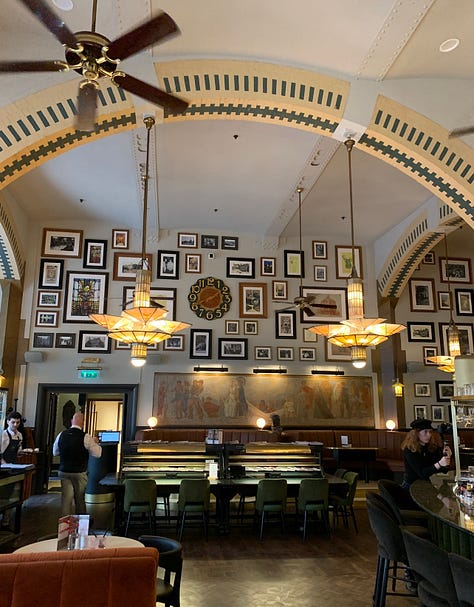
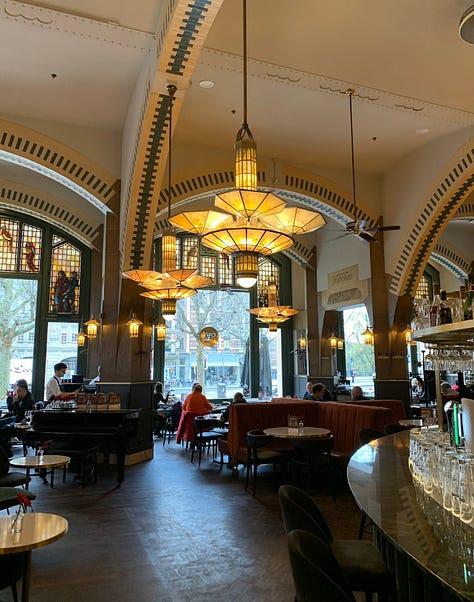
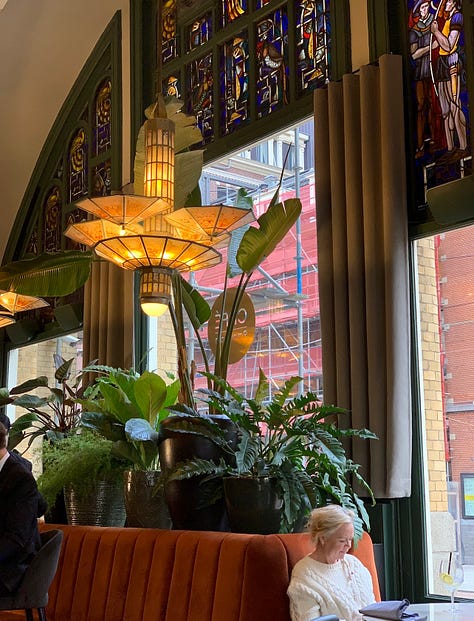
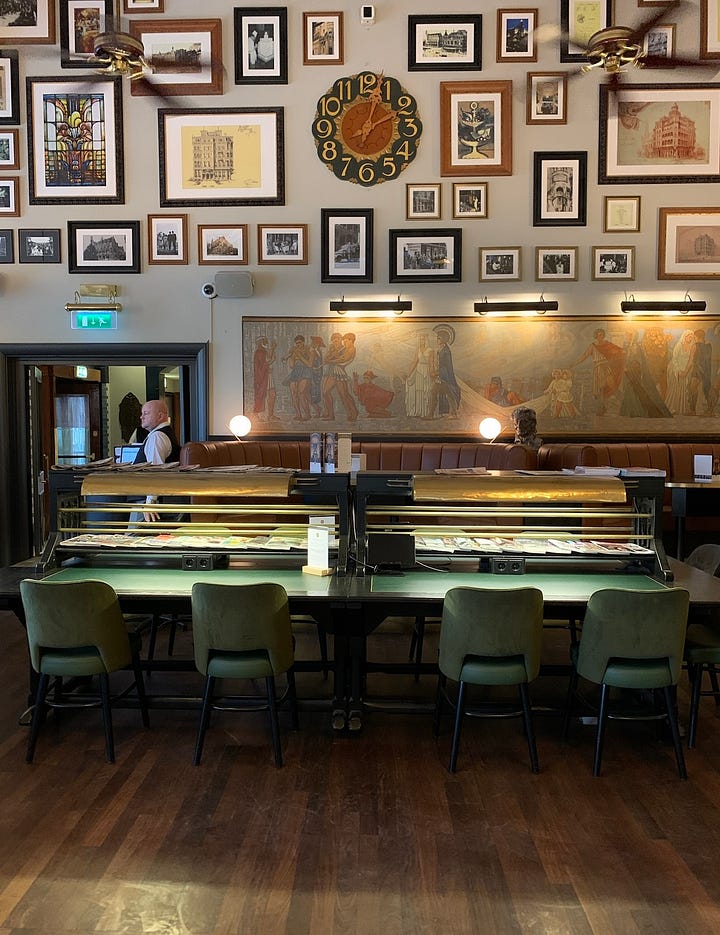
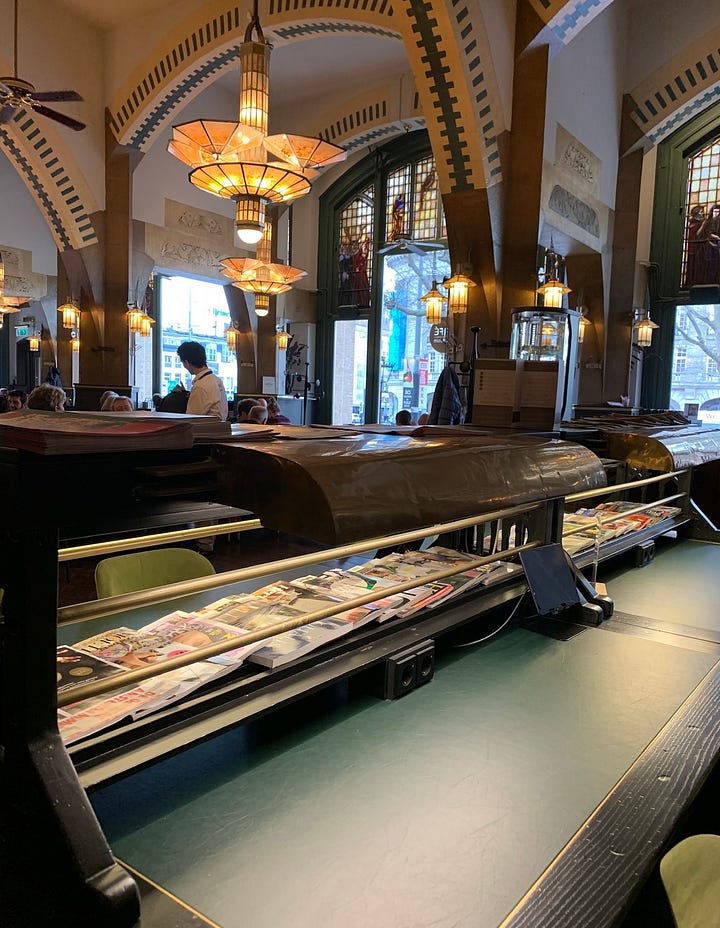





Astonishing story and space (especially those chandeliers). As a longtime hat person who favors the brow-concealing brim, I relate to your observation that a hatted woman is accessible and inaccessible at the same time. Hats impart mystery to the face.
I really look forward to your writing. So personal yet also so objective. Thanks Lyn, for so beautifully baring your soul.